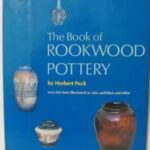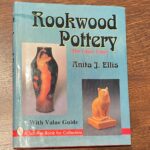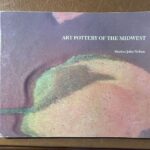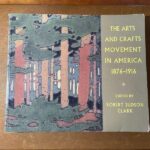Books
Books about art share common criteria: they offer carefully curated examples of the chosen genre, selected based on historical context, skill in execution and aesthetic qualities exhibited. Certainly knowing the history and milieu from which the works arose adds to appreciation and enjoyment. But in the last element, ay, there’s the rub: because a scholar has mustered all the relevant facts, often at enormous expenditure of time and effort, does that make her judgment as to the ultimate value and importance of the object superior, even infallible?
Inevitably, when it comes to art, the final “thumbs up” depends on the viewer’s visceral emotional reaction. You might admire endlessly the workmanship and quality of the Scarab Vase by Adelaide Alsop Robineau, but would you want it in your living room? What makes museum pieces extraordinary doesn’t always make you want to live with them.
The greatest value of books about art is imparted when the author not only has done his homework, but has the knack of identifying and describing the aesthetic qualities that spark a pleasurable reaction. If you read books about art, you will encounter pedantic writers whose overly precious word salads demand multiple readings and still leave you confused and befuddled. There’s a point at which the piece is unable to bear the weight of the analysis.
Happily, collectors realize that no matter how erudite and well-informed you are, in the final analysis you have to trust your own judgment, and that’s what makes collecting rewarding.
The History page is only a brief synopsis of Rookwood’s history and its place in the American art pottery movement. Fortunately many scholars and devotees have produced a wealth of books and articles that delve into greater detail on the subject, illuminating not only the historical facts but the artistic qualities that make Rookwood a perennial favorite. The following are particularly useful:
 Herbert Peck, The Book of Rookwood Pottery (1968). Contains the definitive history of the pottery from the beginning until its demise in 1967, as well as a list of Rookwood artists and decorators and their ciphers.
Herbert Peck, The Book of Rookwood Pottery (1968). Contains the definitive history of the pottery from the beginning until its demise in 1967, as well as a list of Rookwood artists and decorators and their ciphers.
 Herbert Peck, The Second Book of Rookwood Pottery (1985). Companion to the foregoing. Offers some corrections to the earlier work, adds considerable new material (including an updated list of artists), and most importantly contains the complete record book of all Rookwood shapes from no. 1 (1880) to no. 7301 (1967), with descriptions, dimensions and a small drawing or photograph of each shape.
Herbert Peck, The Second Book of Rookwood Pottery (1985). Companion to the foregoing. Offers some corrections to the earlier work, adds considerable new material (including an updated list of artists), and most importantly contains the complete record book of all Rookwood shapes from no. 1 (1880) to no. 7301 (1967), with descriptions, dimensions and a small drawing or photograph of each shape.
 Alice Cooney Frelinghuysen, Martin Eidelberg and Adrienne Spinozzi, American Art Pottery: The Robert A. Ellison Collection (2018). An impressively detailed, beautifully illustrated and comprehensive survey of American art pottery, largely devoted to the important art pottery collection donated to the Metropolitan Museum of Art by famed collector Robert A. Ellison. Reflects an extraordinary depth of understanding in tracing how American potteries absorbed and transformed European and Asian influences, ultimately emerging with their own distinct styles. Regarding Rookwood, see pp. 72-89, 179-91. The pieces shown in this book are rare, museum-quality items, well beyond the reach of the average collector. However, a book such as this helps to develop an eye for quality and value. In this era of easily accessible online auctions, that understanding, combined with patience and assiduity, can enable even a modest collector to assemble a pleasing collection. Regarding the Ellison collection, see Robert Ellison: Pioneering Pottery Collector, Style 1900 magazine, Vol. 22 No. 2, pp. 78-81 (2009).
Alice Cooney Frelinghuysen, Martin Eidelberg and Adrienne Spinozzi, American Art Pottery: The Robert A. Ellison Collection (2018). An impressively detailed, beautifully illustrated and comprehensive survey of American art pottery, largely devoted to the important art pottery collection donated to the Metropolitan Museum of Art by famed collector Robert A. Ellison. Reflects an extraordinary depth of understanding in tracing how American potteries absorbed and transformed European and Asian influences, ultimately emerging with their own distinct styles. Regarding Rookwood, see pp. 72-89, 179-91. The pieces shown in this book are rare, museum-quality items, well beyond the reach of the average collector. However, a book such as this helps to develop an eye for quality and value. In this era of easily accessible online auctions, that understanding, combined with patience and assiduity, can enable even a modest collector to assemble a pleasing collection. Regarding the Ellison collection, see Robert Ellison: Pioneering Pottery Collector, Style 1900 magazine, Vol. 22 No. 2, pp. 78-81 (2009).
 Anita J. Ellis, Rookwood Pottery: The Glaze Lines (1995). Over Rookwood’s 80-plus year existence, the company’s thousands of shapes were adorned with a wide variety of different glazes. The product of endless research and experimentation by the company (reportedly 40,000 usable glazes were developed), the glaze lines were given poetic names loosely based on color, degree of matte or gloss, decorative style and texture. However, Rookwood failed to reliably mark its pieces to indicate glaze lines, to record dates of introduction, or to preserve photographic records. Moreover, the glaze lines overlap, so that many pieces cannot definitively be attributed to a particular glaze line. (Is that Conventional Mat, Modeled Mat, Incised Mat or Mat Moderne?) Since glaze lines can be amorphous and confusing, once you get past the most popular lines, like Vellum, Iris and Standard, they aren’t very helpful or informative. (On this website glaze lines, other than those just mentioned and the rare and valuable French Red, are not noted.) The author of this book tries gamely to sort them out, describing and showing examples of each glaze line, although she doesn’t provide shape numbers, which would be helpful. The best thing about the book is the photos, which are sharp, large and in color.
Anita J. Ellis, Rookwood Pottery: The Glaze Lines (1995). Over Rookwood’s 80-plus year existence, the company’s thousands of shapes were adorned with a wide variety of different glazes. The product of endless research and experimentation by the company (reportedly 40,000 usable glazes were developed), the glaze lines were given poetic names loosely based on color, degree of matte or gloss, decorative style and texture. However, Rookwood failed to reliably mark its pieces to indicate glaze lines, to record dates of introduction, or to preserve photographic records. Moreover, the glaze lines overlap, so that many pieces cannot definitively be attributed to a particular glaze line. (Is that Conventional Mat, Modeled Mat, Incised Mat or Mat Moderne?) Since glaze lines can be amorphous and confusing, once you get past the most popular lines, like Vellum, Iris and Standard, they aren’t very helpful or informative. (On this website glaze lines, other than those just mentioned and the rare and valuable French Red, are not noted.) The author of this book tries gamely to sort them out, describing and showing examples of each glaze line, although she doesn’t provide shape numbers, which would be helpful. The best thing about the book is the photos, which are sharp, large and in color.
 Marion John Nelson, Art Pottery of the Midwest (1988). Ohio was the home of the largest American art potteries, and important contributions to the field were made by potteries in adjoining states. Thus, geographical limitations do not preclude this author from presenting a comprehensive overview of design characteristics and historical development, including European and Asian influences and cross-fertilization between potteries. Recognizing that cast forms are not inherently inferior, eschews the dichotomy between hand-thrown, hand-decorated pottery and “industrial art ware” cast in molds. Instead, “organic” styles incorporating naturalistic imagery (most signed Rookwood, Roseville and Weller) are contrasted with “abstract” non-representational styles emphasizing shape and glaze (Rookwood production, Pewabic and Teco). (Aficionados of Fulper pottery will appreciate the latter approach, although that New Jersey brand is outside the geographic scope of the book. The latter approach is also more congruent with the Arts and Crafts aesthetic.) Most of the photos are small and in black and white, making it difficult to discern the qualities described. (Side trips to the internet for better photos are helpful.) Written to accompany an exhibition at the University of Minnesota, this is one of the most penetrating of such catalogs; it accordingly has become a fixture of the art pottery literature.
Marion John Nelson, Art Pottery of the Midwest (1988). Ohio was the home of the largest American art potteries, and important contributions to the field were made by potteries in adjoining states. Thus, geographical limitations do not preclude this author from presenting a comprehensive overview of design characteristics and historical development, including European and Asian influences and cross-fertilization between potteries. Recognizing that cast forms are not inherently inferior, eschews the dichotomy between hand-thrown, hand-decorated pottery and “industrial art ware” cast in molds. Instead, “organic” styles incorporating naturalistic imagery (most signed Rookwood, Roseville and Weller) are contrasted with “abstract” non-representational styles emphasizing shape and glaze (Rookwood production, Pewabic and Teco). (Aficionados of Fulper pottery will appreciate the latter approach, although that New Jersey brand is outside the geographic scope of the book. The latter approach is also more congruent with the Arts and Crafts aesthetic.) Most of the photos are small and in black and white, making it difficult to discern the qualities described. (Side trips to the internet for better photos are helpful.) Written to accompany an exhibition at the University of Minnesota, this is one of the most penetrating of such catalogs; it accordingly has become a fixture of the art pottery literature.
 Robert Judson Clark ed., The Arts and Crafts Movement in America: 1876-1916 (1972). Rookwood’s decline began in the 1930s and culminated with the company’s demise in 1967. During that period, public interest in the Arts and Crafts movement became equally moribund. Many valuable pieces of pottery, furniture, lighting and metalwork were lost due to neglect. The 1972 exhibition entitled The Arts and Crafts Movement in America: 1876-1916, however, sparked renewed interest in Arts and Crafts design. This book is the catalog for that pioneering exhibition, which contained an extensive and remarkable array of Arts and Crafts objects, including “the first comprehensive display of American art pottery” (p. ix). The pottery display was curated by Martin Eidelberg, who adds his keenly perceptive analysis to this catalog. Eidelberg is a major figure in the Arts and Crafts revival (especially pottery) through his writings and his 2021 contribution of his pottery collection to the Metropolitan Museum of Art. (A catalog devoted to that collection, entitled Gifts from the Fire, has been published by the Met.) This 1972 catalog is an historic and seminal document in the revival, which experienced a lull roughly between 2008-2020 but in the 2020s is being kept alive by a small but devoted fanbase.
Robert Judson Clark ed., The Arts and Crafts Movement in America: 1876-1916 (1972). Rookwood’s decline began in the 1930s and culminated with the company’s demise in 1967. During that period, public interest in the Arts and Crafts movement became equally moribund. Many valuable pieces of pottery, furniture, lighting and metalwork were lost due to neglect. The 1972 exhibition entitled The Arts and Crafts Movement in America: 1876-1916, however, sparked renewed interest in Arts and Crafts design. This book is the catalog for that pioneering exhibition, which contained an extensive and remarkable array of Arts and Crafts objects, including “the first comprehensive display of American art pottery” (p. ix). The pottery display was curated by Martin Eidelberg, who adds his keenly perceptive analysis to this catalog. Eidelberg is a major figure in the Arts and Crafts revival (especially pottery) through his writings and his 2021 contribution of his pottery collection to the Metropolitan Museum of Art. (A catalog devoted to that collection, entitled Gifts from the Fire, has been published by the Met.) This 1972 catalog is an historic and seminal document in the revival, which experienced a lull roughly between 2008-2020 but in the 2020s is being kept alive by a small but devoted fanbase.
 Judith Budwig and Jeffrey Preston, Redux: The Arts and Crafts Revival 1972-2012 (2013). A colorful retracing of the Arts and Crafts revival as seen through the eyes of its key figures, including Martin Eidelberg and Robert Judson Clark. As of 2024, many of the dealers/auctioneers profiled are still in business.
Judith Budwig and Jeffrey Preston, Redux: The Arts and Crafts Revival 1972-2012 (2013). A colorful retracing of the Arts and Crafts revival as seen through the eyes of its key figures, including Martin Eidelberg and Robert Judson Clark. As of 2024, many of the dealers/auctioneers profiled are still in business.
